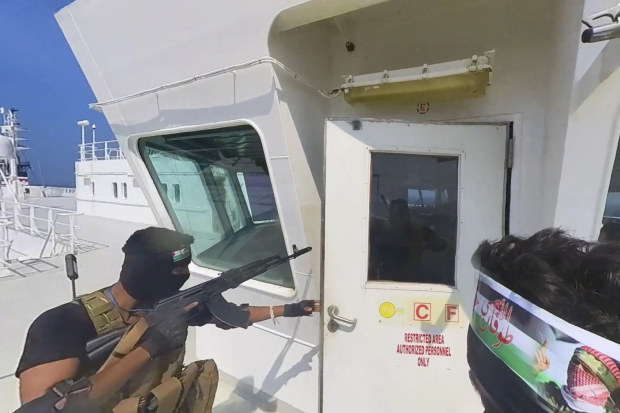Is Australia’s delay on US warship request dithering or prudent?
The opposition accuses the government of dithering. But it would be a dangerous mission, and there are powerful historical precedents.

The government’s delay in deciding whether to commit an Australian warship to the Red Sea can be read two ways.
From the government’s perspective, it provides time to assess what Australia can meaningfully contribute, while not taking its strategic eye off the nation’s immediate area of concern in the Asia-Pacific.
It knows, too, that this would be a dangerous mission. It would be no simple flying of the flag – the ship would be going into harm’s way to protect vital international trading routes against Iranian-backed Houthi rebels. There is the very real potential of military casualties.

A photo released by the Houthi Media Centre shows a Houthi gunman on the cargo ship Galaxy Leader on November 19. AP
The opposition portrays it as more defence dither from the government. Its critique reads something like this: Labor’s delay on answering the request from the United States is worryingly consistent with its decision to break from Washington in endorsing a UN call for an immediate humanitarian ceasefire in Gaza.
Also, the delay is another expression of Labor’s moral confusion on the current Middle East crisis. After all, US and British ships, along with the French, are already on duty in the Red Sea, and more European countries are likely to answer the American call.
Further, the delay follows embarrassingly close on the heels of the US Congress passing enabling legislation for both pillars of the AUKUS agreement.
In this reading, Australia’s alliance credentials are on the line. Labor gets branded as leaving its AUKUS partners to do the heavy lifting in the Red Sea.
The optics of the delay are compounded by surprising comments from the Chief of Navy, Rear-Admiral Christopher Smith, who went public over the weekend declaring the navy ready to dispatch a warship should the government agree to the request.
Serious strain on resources
At the very least, that statement demonstrates the lack of coherence in the government’s advice and decision-making processes on these types of questions.
Especially given that Defence Minister Richard Marles had already said late last week that the government would take its time in reaching a decision. The rear-admiral’s comments could easily be interpreted as pressuring the National Security Committee of cabinet to get cracking on a decision in favour of deployment.
But strategic analysts point out that sending one ship into the Red Sea would seriously strain Australian naval resources, including crews, and that no Australian vessel is well-equipped to counter the drones being used by the Houthi rebels.
It is understood that Australian officials are talking with American counterparts on just how critical Australian involvement would be.
Marles has said that Australia’s focus is its “immediate region” and that the government will “work through with the Americans about how best we can contribute”. That also means gauging what kind of request we are dealing with – a scattergun US Navy request for as many naval flags as possible for an international task force, or one with the gravitas of White House or Pentagon backing.
As respected international relations scholar Andrew Carr has shown, Australian governments of both political persuasions have over the last decade “steadily pulled back [their] zone of concern” from the Middle East to Asia. Taken together, the focus of defence white papers in 2013 and 2016, the defence update in 2020, and this year’s Defence Strategic Review has Australia’s strategic lens specifically trained on the Indian Ocean, South-East Asia and the Pacific.
The government’s delay does, however, have powerful historical precedents.
The opposition would do well to remember that at the outbreak of the World War II, then-prime minister Robert Menzies refused a British request to commit Australian forces immediately to the Middle East until he had received assurances that Britain would send the Royal Navy to assist Australia in the event of a threat to its security from Japan.
And Labor’s John Curtin, even after becoming prime minister in October 1941, did not immediately adopt an “Australia first” position and demand the return of Australian troops from the Middle East theatre. That stance came later, and with considerable force.
Washington not always eager
It might also be remembered that when in recent decades Australia has asked America for help, Washington has not always been so eager. Recall US president Bill Clinton’s refusal to provide US marines during the East Timor crisis of 1999. American logistical, diplomatic and intelligence assistance ultimately proved critical to the success of that mission, but the expectation in Canberra was that Australia had paid enough alliance dues in the past to merit American troops being sent.
There will be a great gnashing of alliance teeth, particularly at the operational level, if Australia says no to a Red Sea deployment. But the serious political operatives in Washington might very well understand Canberra’s predicament. And there might be even more respect for an ally whose default position is not instinctive obeisance.
The US itself, after all, has been asking Australia to do more in Asia, not the Middle East.
On the other hand, of course, both major parties here have long talked of the American alliance as one with global, not just regional interests and reach.
So Australia is once more facing up to the question of whether its big talk can be matched by a meaningful military commitment.
Introducing your Newsfeed
Follow the topics, people and companies that matter to you.
Find out moreRead More
Latest In Foreign affairs & security
Fetching latest articles